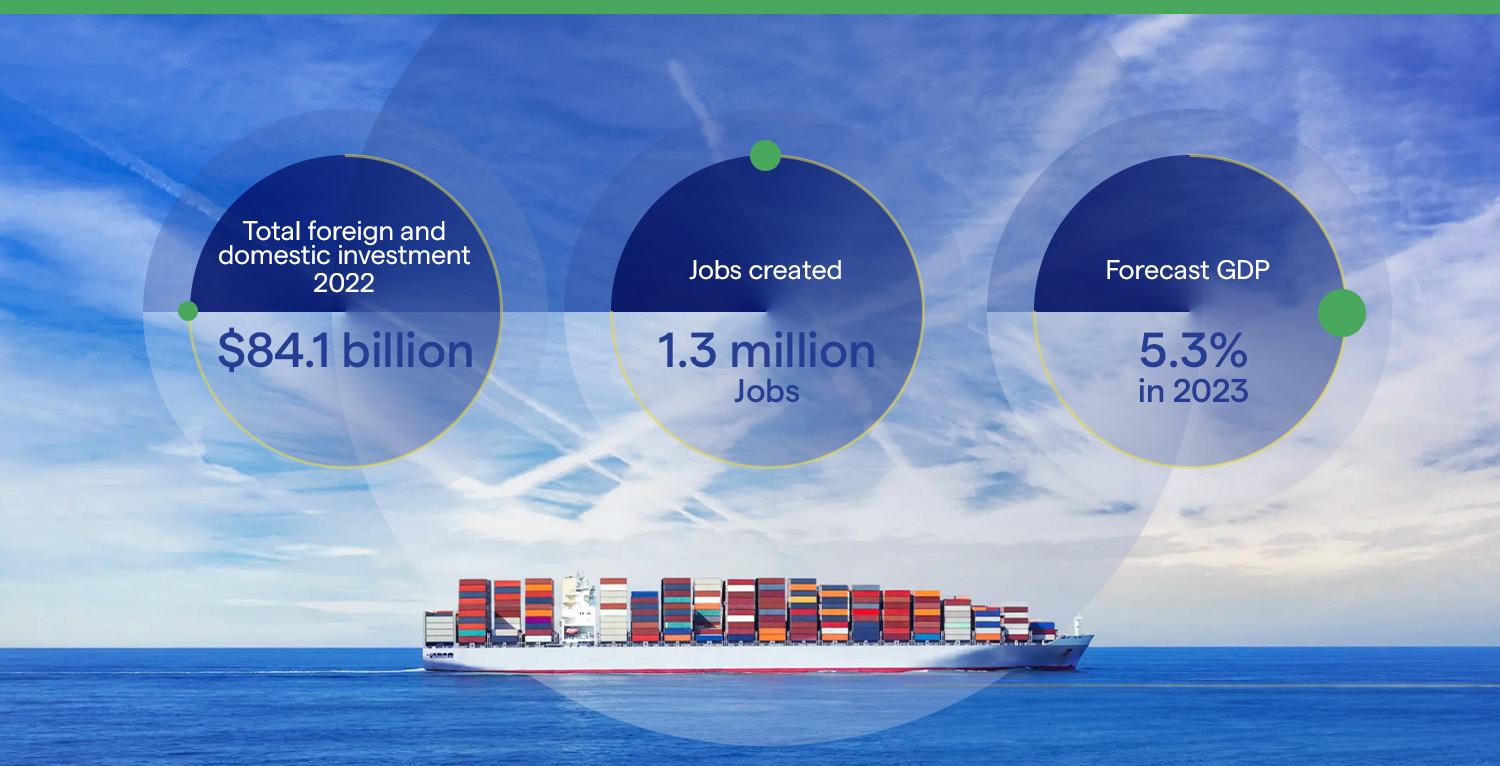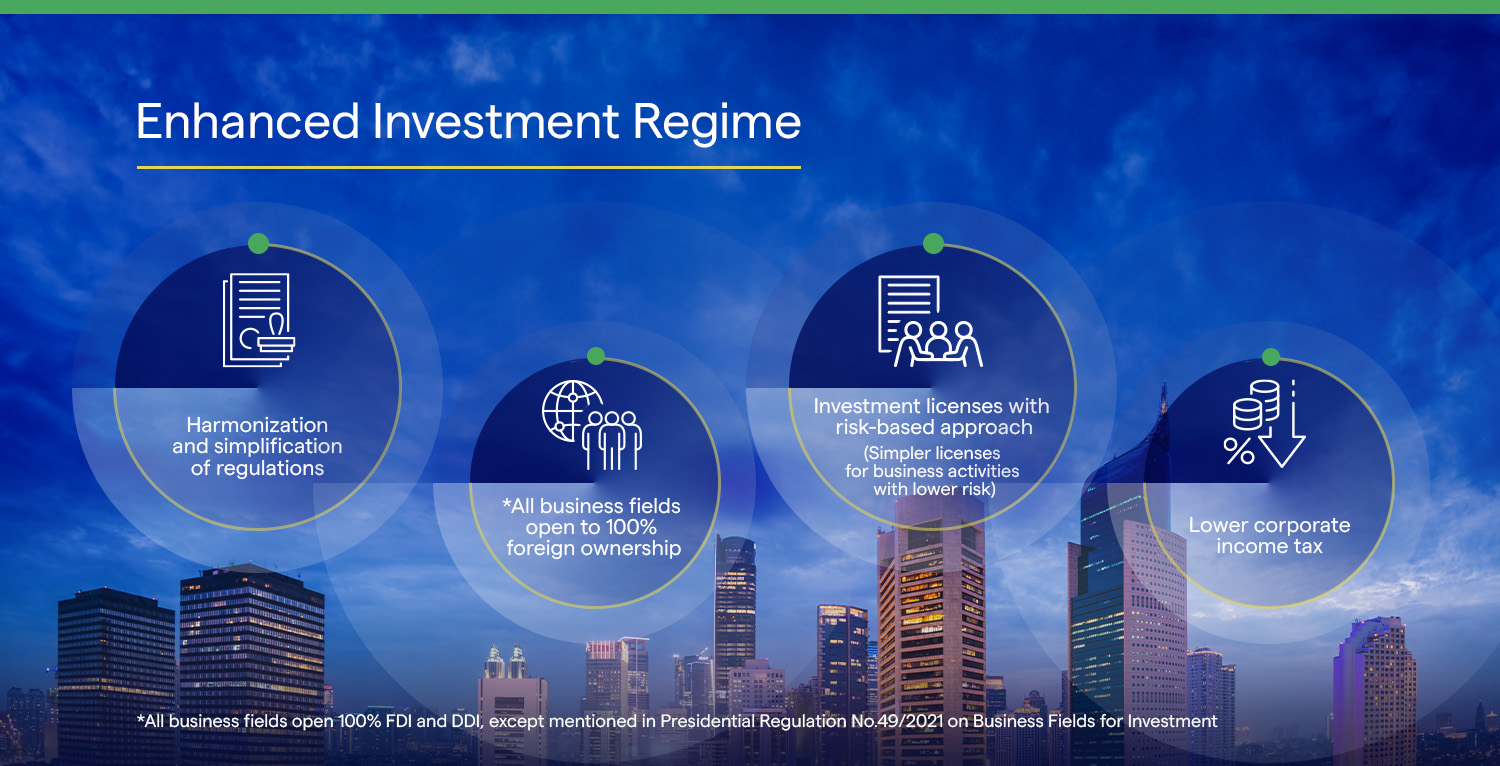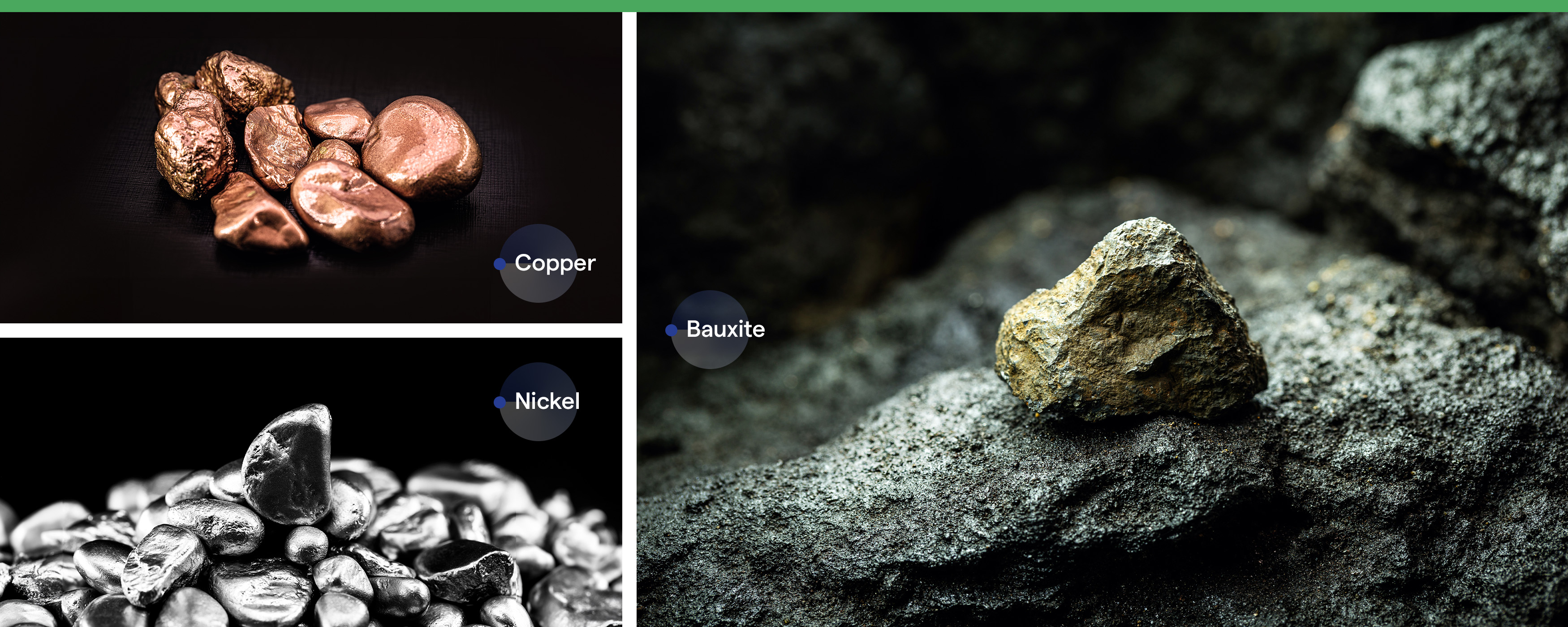Opportunity Indonesia: Opening Doors to Foreign Investment
For foreign investors eyeing Indonesia, this is a breakthrough moment.
Southeast Asia’s largest economy is on the cusp of a bold transformation that could unlock unprecedented opportunities, and many overseas investors are already jumping onboard.
In 2022, even as the global economy stuttered, growth in Indonesia returned to pre-pandemic levels, driven by surging exports and domestic demand. As a result, total foreign and domestic investment hit a record $84.1 billion,1 creating 1.3 million jobs. This year, the central bank forecasts growth to reach as much as 5.3%, among the fastest in the G20.2
For centuries, Indonesia has been prized around the world as a rich source of natural resources, but until recently those resources were often exported raw and turned into higher-value products elsewhere.

Now, the government is focused on stimulating foreign direct investment (FDI) in resource development and downstream processing that will boost the country’s end-to-end manufacturing capabilities, cement its growing importance as a center of regional and global trade, and accelerate national development.
To meet these goals, Indonesia is targeting $545 billion in FDI through 2040 to develop 21 commodities in several key sectors, including minerals, coal, oil, natural gas, plantations, marine, forestry, and fisheries.
“We are simultaneously improving our road infrastructure, embracing downstream, improving the financial sector, and increasing regulations and incentives as a stimulus to attract investors,” Minister of Investment/Chairman of BKPM, Mr. Bahlil Lahadalia, said at a press conference in Jakarta on 21 July.
In addition, the government has launched 69 sustainable investment projects with a pre-FS available. This provides a great opportunity for investors to contribute to the Indonesian development. Sustainability is no longer an option, but a necessity in present and future business development.
An Open Environment
Indonesia offers many of the advantages overseas investors are seeking at a time of global uncertainty.
Labor costs remain low compared with Asia’s other major economies3 including China, Vietnam, Malaysia, Thailand, and the Philippines. The country also enjoys political stability and a young, educated population—almost half of its people are aged between 18 and 39.4
This dynamic workforce lies at the center of the Association of Southeast Asian Nations (ASEAN) market, a burgeoning free-trade zone that, according to the International Monetary Fund, will be the fastest-growing region in the world in 2023 and 2024.5
Indonesia’s investment policies are increasingly attractive. Its Positive Investment List allows foreign investors to fully own businesses in more than 200 sectors—including oil and gas construction, electricity generation, seaports, and maritime cargo6—as well as access to fiscal and non-fiscal incentives.

Indonesia is also committed to create starting a business in Indonesia hassle-free. The Job Creation Law/Omnibus Law was signed in 2020 as a major breakthrough that aims to create vast job opportunities by improving investment climate and legal certainty, harmonizing central-regional policies, and simplifying regulation.
As the implementation of Job Creation Law, Indonesia launched new licensing system that is called the Risk-Based Online Single Submission (OSS RBA) System, in which Ministry of Investment/BKPM issues licenses and facilities for all sectors through OSS system.
“We are simultaneously improving our road infrastructure, embracing downstream, improving the financial sector, and increasing regulations and incentives as a stimulus to attract investors.”
— Minister of Investment/Chairman of BKPM, Mr. Bahlil Lahadalia
Supplies for a Sustainable Future
Indonesia is already one of the world’s most important sources of the minerals on which the global economy relies. Today, foreign investors have a unique opportunity to be part of a fast-growing success story as demand for critical elements booms.
Indonesia possesses a wealth of mineral resources and is a major producer of nickel, tin, copper, bauxite, manganese, zinc and lead. And even though mining already accounts for about 10% of gross domestic product, there are still large, undeveloped mineral deposits that will fuel the country’s progress into downstream production.
Investment in these resources, particularly downstream operations, is ramping up fast. In 2022, investment in the metals industry grew 46% from the year before to IDR171.2 trillion ($11.1 billion), and the contribution of metals to investment realization in Indonesia has doubled since 2019 to 14.2%.
“Downstreaming is the creation of added value,” Minister of Investment/Chairman of BKPM, Mr. Bahlil Lahadalia said at another press conference on June 30. “For example, our nickel exports were only $3.3 billion from 2017 to 2018. As soon as we stopped raw nickel exports and downstreamed our exports instead, the value increased to nearly $30 billion by 2022. As a result of downstreaming, we will encourage our exports to no longer be in the form of commodities, but in the form of semi-finished and finished goods.”
Nickel and bauxite will play particularly important roles in the industry’s future.

Indonesia has the world’s largest reserves of nickel, which is a critical ingredient of the batteries that will power the future of transportation, and the country is expected to account for half of the global nickel production increase through 2025.
To transform that resource advantage into globally competitive downstream industries, the government is targeting $127 billion in investment through 2040 to help meet an expected $5.9 trillion in global demand for Electric Vehicle (EV) battery packs.
“We will encourage our exports to no longer be in the form of commodities, but in the form of semi-finished and finished goods."
— Minister of Investment/Chairman of BKPM, Mr. Bahlil Lahadalia
Already this year, one British consortium has agreed to invest $9 billion in Indonesia’s mining and EV battery sector.7
Global demand for bauxite is also expected to accelerate as the world transitions to cleaner forms of energy and transportation. Bauxite is a key element in the aluminium used for EV components, and is a critical ingredient in solar photovoltaic cells, demand for which will soar to an estimated $2.9 trillion a year by 2045.
With overseas investment of $51 billion through 2035, Indonesia can realize additional value of as much as 197x by transforming raw bauxite into the products that will form an essential part of the world’s sustainable future.
Supporting the Energy Transition
While it is generally accepted that the global economy needs to transition away from fossil fuel dependence, the world will need steady and secure supplies of oil and natural gas for many years to come.
In fact, global oil demand is forecast to continue growing through at least 2028, according to International Energy Agency estimates.8
Indonesia will play a significant part in the transition via enormous planned investments in EV and clean energy technologies, but it also plans to have a role in ensuring the world’s energy security until that transition is complete.
To achieve this, the government is boosting efforts to attract annual overseas investment of up to $20 billion to help revive stalled projects, lift crude oil production to 1 million barrels per day, and increase natural gas output to 12 billion standard cubic feet per day by 2030. Exploration has resumed in recent years, with significant discoveries such as the Timpan gas field in the Andaman Sea.
Meanwhile, Indonesia has created a roadmap towards net zero emissions by 2060. This includes diversifying its energy mix through the expansion of its on-grid solar energy network, the introduction of biomass co-firing at coal-powered plants and tapping the world’s largest potential reservoirs of geothermal energy.9 The latter is viewed as a viable counterweight to the intermittency of solar and wind power.
The Indonesian government is also prioritizing the country’s electrification by improving its electricity infrastructure to enable more electric vehicles to take to the roads – and increasing the roll-out of rooftop solar PV panels.

However, the speed and success of the energy transition will require the continued support of private investors. An estimated $50 billion in investment is needed by 2030 to add 20.9 gigawatts (GW) of renewable energy capacity to Indonesia’s grid.10 Current global renewable power capacity sits at 3,372 GW.11 According to Indonesia’s Ministry of Energy and Mineral Resources, only 0.3% of the country’s potential renewable energy has been utilized, underscoring the massive opportunity here for investors to align profit with purpose.
[1] Jakarta Globe [2] ASEAN [3] China Briefing [4] Indonesia Central Bureau of Statistics 2022 [5] International Monetary Fund [6] ASEAN Briefing [7] Reuters [8] IEA [9] Asian Development Bank [10] State Power Company (PLN)/BKPM [11] IRENA
